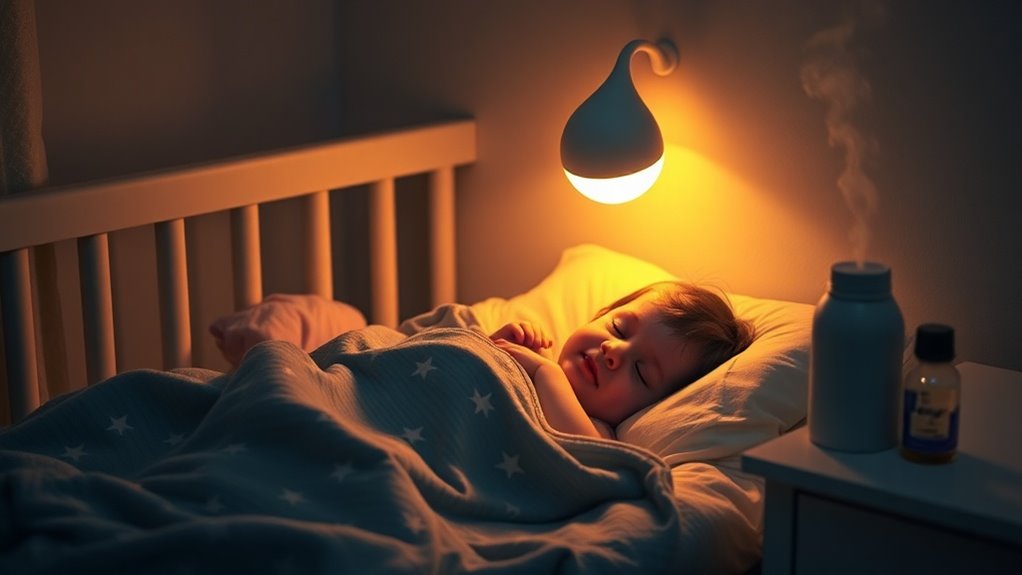The Remedy That Finally Helped My Kid Sleep Through the Night
Our Sleep Struggles: A Parent’s Journey
Many parents face the nightly challenge of getting their children to sleep and keeping them asleep. You’ve likely tried various natural sleep remedies, from lavender oils to white noise machines, yet your child still struggles with bedtime resistance and frequent wake-ups.
Your concerns are valid. Research shows that inadequate sleep affects children’s cognitive development, emotional regulation, and physical growth. Optimal sleep quality often involves establishing a consistent bedtime routine, which can significantly improve your child’s ability to fall asleep and stay asleep throughout the night.
When your child isn’t sleeping well, the entire family suffers. You feel exhausted, frustrated, and worried about your child’s well-being. The search for effective solutions becomes increasingly urgent as sleep deprivation takes its toll on daily functioning.
Understanding Sleep Patterns in Children
Children’s sleep patterns evolve significantly throughout their development, with distinct changes occurring from infancy through adolescence. Understanding your child’s natural sleep rhythms helps you establish appropriate bedtime routines and expectations.
-
Newborns sleep 14-17 hours in sporadic intervals, with frequent night wakings for feeding.
-
Toddlers need 11-14 hours, transitioning to one consolidated nighttime sleep period.
-
School-age children require 9-11 hours, with circadian rhythms becoming more regular.
-
Teenagers experience a natural shift in melatonin production, making them biologically prone to later bedtimes.
These age-specific patterns reflect your child’s neurological development and hormonal changes.
Common Causes of Sleep Disruption
While sleep patterns naturally vary by age, several factors can disrupt your child’s regular sleep cycle.
Common triggers include inconsistent bedtime routines, excessive screen time before bed, and irregular meal schedules. Environmental factors like room temperature, noise levels, and lighting can significantly impact sleep quality.
Your child’s emotional state plays a crucial role too. Anxiety, stress from school, or family changes often manifest as sleep difficulties.
Medical conditions such as sleep apnea, allergies, or acid reflux can also interfere with rest. Additionally, certain medications, caffeine consumption, and intense physical activity close to bedtime may prevent your child from falling asleep easily.
The Natural Sleep Solution We Found
After extensive research and consultation with pediatric sleep specialists, we discovered that a combination of chamomile tea and lavender aromatherapy proved remarkably effective for our young patients.
This natural approach aligns with evidence-based sleep hygiene practices for children.
- Serve lukewarm chamomile tea (caffeine-free) 30 minutes before bedtime
- Place 2-3 drops of therapeutic-grade lavender oil in a diffuser near the bed
- Dim lights and maintain room temperature between 68-72°F (20-22°C)
- Create a consistent bedtime ritual incorporating both remedies
Clinical studies show these natural solutions can reduce sleep latency and improve sleep quality in children ages 4-12. Additionally, incorporating herbal blends like Ashwagandha can further enhance the effectiveness of bedtime routines.
Implementing a Bedtime Routine
Establishing a consistent bedtime routine serves as the foundation for your child’s healthy sleep habits. Research shows that predictable patterns help regulate your child’s circadian rhythm and trigger natural sleep hormones.
| Time | Activity | Purpose |
|---|---|---|
| 7:00 PM | Warm bath | Raises body temperature |
| 7:20 PM | Pajamas & teeth | Physical preparation |
| 7:30 PM | Dim lights | Melatonin production |
| 7:40 PM | Story time | Mental wind-down |
| 7:50 PM | Goodnight ritual | Security & closure |
You’ll want to maintain these times consistently, even on weekends. When your child knows what to expect, they’re more likely to transition smoothly into sleep mode.
Addressing Environmental Factors
You’ll find that managing your child’s sleep environment plays a crucial role in promoting quality rest, with key factors including room temperature, lighting, and bedding choices.
Research shows that maintaining a cool room temperature between 68-72°F (20-22°C) with adequate ventilation helps regulate your child’s body temperature for optimal sleep.
Blackout curtains can block disruptive light, while white noise machines can mask sudden sounds that might wake your child.
Comfortable, breathable bedding ensures they stay cozy throughout the night.
Room Temperature and Ventilation
When creating an optimal sleep environment for children, maintaining the right room temperature and proper ventilation plays a crucial role in their sleep quality. Research indicates that a cool, well-ventilated room promotes better sleep patterns in children.
-
Keep the room temperature between 68-72°F (20-22°C), as this range supports your child’s natural drop in body temperature during sleep.
-
Install a small fan to maintain air circulation and create gentle white noise.
-
Open windows for 15-20 minutes before bedtime to release stale air and reduce CO2 levels.
-
Monitor humidity levels, aiming for 40-50% to prevent respiratory discomfort.
Lighting and Sound Control
Two key environmental factors – lighting and sound levels – significantly impact a child’s ability to fall and stay asleep.
You’ll want to dim the lights 30-60 minutes before bedtime to trigger your child’s natural melatonin production.
Install blackout curtains to block street lights and early morning sun. A small nightlight (less than 5 watts) can provide comfort without disrupting sleep.
For sound control, maintain a quiet environment below 30 decibels.
Consider using a white noise machine to mask sudden household or outdoor sounds. Set it 5-7 feet from your child’s bed at a consistent, gentle volume that mimics background noise.
Bedding and Comfort Level
Creating the right sleep environment requires carefully selected bedding that maintains optimal body temperature and comfort.
Your child’s bed should promote relaxation and support their natural sleep patterns through appropriate materials and layering.
-
Choose breathable cotton sheets with a thread count between 200-400 to regulate temperature and prevent night sweats.
-
Layer with a medium-weight comforter filled with hypoallergenic materials.
-
Provide 2-3 pillows of varying firmness to accommodate position changes.
-
Select a mattress with proper support for your child’s weight and sleeping position, typically medium-firm for growing bodies.
Always check bedding for signs of wear and replace items that no longer provide adequate support.
Tracking Progress and Setbacks
You’ll gain valuable insights into your child’s sleep patterns by maintaining detailed sleep diary records that document bedtime routines, wake times, and any nighttime disturbances.
Weekly trend analysis charts help you visualize improvements or challenges in your child’s sleep schedule while making it easier to share specific data with healthcare providers.
Maintaining Sleep Diary Records
Successfully monitoring your child’s sleep patterns requires maintaining detailed sleep diary records. By documenting sleep behaviors consistently, you’ll identify trends and potential triggers that affect your child’s rest quality.
-
Record bedtime routines, including specific activities and their duration.
-
Note sleep onset time, night wakings, and morning wake-up time.
-
Track environmental factors like room temperature, noise levels, and light exposure.
-
Document daily activities that may impact sleep: meals, exercise, screen time, and medications.
These systematic observations help healthcare providers make informed decisions about your child’s sleep treatment plan and allow for timely adjustments when needed.
Weekly Trend Analysis Charts
Regular analysis of your child’s sleep diary through weekly trend charts enables you to visualize patterns and identify both improvements and challenges.
Plot your data points on a graph showing bedtimes, wake times, total sleep duration, and nighttime disturbances. You’ll spot correlations between different factors, such as later bedtimes resulting in more frequent wake-ups.
Track specific interventions you’ve implemented and their impact on sleep quality. Use different colors or symbols to mark significant events like illness, travel, or changes in routine.
These visual representations help you adjust your sleep strategy and communicate effectively with healthcare providers about your child’s progress.
Identifying Sleep Pattern Changes
Monitoring your child’s sleep patterns reveals critical shifts in both progress and regression over time. By tracking these changes systematically, you’ll identify which interventions are working and which need adjustment. This data-driven approach helps optimize your child’s sleep strategy.
-
Record wake times that show a pattern change, like shifting from 2 AM to 4 AM wakings.
-
Document behavior modifications that precede better sleep, such as reduced screen time.
-
Note environmental factors impacting sleep quality, including room temperature and noise levels.
-
Track sleep duration changes across different seasons or life events.
This precise monitoring enables you to make informed adjustments to your child’s sleep routine.
Additional Sleep Support Strategies
Beyond establishing core bedtime routines and sleep habits, parents can implement several evidence-based strategies to enhance their child’s sleep quality.
You’ll want to maintain consistent room temperatures between 68-72°F and use white noise machines to mask disruptive sounds.
Install blackout curtains to regulate light exposure and support natural melatonin production.
Consider weighted blankets for children over age two, which can reduce anxiety and promote deeper sleep.
A nightlight with red wavelengths won’t interfere with sleep cycles.
These environmental modifications, combined with proper sleep hygiene, can significantly improve your child’s rest quality.
Tips for Maintaining Healthy Sleep Habits
Once you’ve established effective sleep strategies, maintaining them requires consistent effort and attention.
To preserve your child’s healthy sleep patterns, implement these evidence-based practices consistently:
-
Set your child’s bedroom temperature between 68-72°F (20-22°C), using a programmable thermostat to maintain optimal sleeping conditions.
-
Dim household lights 1-2 hours before bedtime to support natural melatonin production.
-
Keep electronic devices outside the bedroom and cease screen exposure 60 minutes before sleep.
-
Follow the same bedtime routine every night, even on weekends, to reinforce your child’s circadian rhythm.
These habits strengthen sleep architecture and promote restorative rest.







